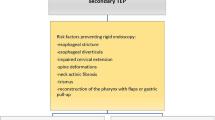Abstract
Post laryngectomy voice rehabilitation using primary tracheoesophageal puncture (TEP) and voice prosthesis insertion is considered the “gold standard” method. No special effort is taken to measure the tracheoesophageal partywall thickness before inserting voice prosthesis. TE puncture related problems (peri-prosthetic leakage) are commonly seen in our population as compared to device failures (central leak). An accurate prosthesis inserted primarily may prevent the development of peri-prosthetic leakage. We surmise that tracheoesophageal party wall thickness (PWT) to be an important factor determining this phenomenon. There is still no consensus on the size of the prosthesis to be inserted during a primary TEP. To cater this, we propose a simple, quick and accurate method of measuring tracheoesophageal PWT intraoperatively. This method will guide us to determine an accurate prosthesis size which can be inserted during primary TEP. We also propose that this method will prevent future TE puncture related problems.



Similar content being viewed by others
References
Hilgers FJM, Balm AJM, Gregor RT et al (2003) A practical guide to post-laryngectomy vocal and pulmonary rehabilitation, 4th edn. http://www.hoofdhalskanker.info/Provoxweb/General_Introduction.htm. Accessed 4 Oct 2012
Brown DH, Hilgers FJM, Irish JC, Balm AJM (2003) Postlaryngectomy voice rehabilitation: state of the art at the millennium. World J Surg 27:824–831
Sayed SI, Manikantan K, Khode S et al (2010) Tracheo-oesophageal party wall thickness in laryngectomised patients in India: implications for surgical voice restoration. J Surg Oncol 101(1):78–83
Mehta AR, Sarkar S, Mehta SA et al (1995) The Indian experience with immediate tracheo-esophageal puncture for voice restoration. Eur Arch Otorhinolaryngol 252:209–221
Op de Coul BM, Hilgers FJ, Balm AJ et al (2000) A decade of postlaryngectomy vocal rehabilitation in 318 patients: a single Institution’s experience with consistent application of Provox1 indwelling voice prostheses. Arch Otolaryngol Head Neck Surg 126:1320–1328
Author information
Authors and Affiliations
Corresponding author
Rights and permissions
About this article
Cite this article
Sayed, S., Chaukar, D., Chaturvedi, P. et al. Intraoperative Tracheoesophageal Partywall Thickness (PWT) Measurement in Laryngectomy Patients Using Modified PROVOX Guidewire. Indian J Otolaryngol Head Neck Surg 65, 71–75 (2013). https://doi.org/10.1007/s12070-012-0607-5
Received:
Accepted:
Published:
Issue Date:
DOI: https://doi.org/10.1007/s12070-012-0607-5




